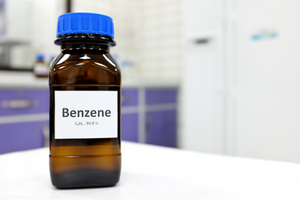In 1825, the English physician and chemist Michael Faraday accidentally discovered benzene by condensing illuminating gas (town gas). In those times, nobody predicted that this transparent liquid would become one of the most revolutionary raw materials, without which the contemporary industry could not exist. What are the properties and applications of benzene?

What is benzene? Formula and structure
What is the simplest way to define benzene? The molecular formula of this organic compound is C6H6, which means that for 6 atoms of carbon (C) there are 6 atoms of hydrogen (H) in it. Benzene, along with other compounds, such as naphthalene, belongs to the group of aromatic hydrocarbons.
What else is specific to benzene? The structure of its molecule is shaped as a ring, which is typical of aromatic hydrocarbons. If we take a look at the molecule of benzene, its semi-structural formula or 3D model, we will notice that the ring’s proportional arms form interconnected, single atoms of carbon and hydrogen.
Production of benzene
It is almost 200 years since C6H6 was discovered. For decades, industrialists have been continuously improving the reactions producing benzene in order for their production processes to be profitable and generate as little poisonous waste as possible. There are various technologies of producing that hydrocarbon. It is formed, for example, by:
- isolating benzene rings from gas tar,
- reforming petroleum,
- dealkylation, that is removing the alkyl group from certain aromatic hydrocarbons (e.g., toluene).
Please note that benzene is highly toxic. In controlled conditions, the production of benzene, reforming or dealkylation require special precautions. What are the physico-chemical properties of benzene? Let’s check!
Benzene: safety data sheet, physical properties
Many people can easily recognise benzene – its odour is very intensive and slightly sweet, resembling plastic. The liquid is transparent and insoluble or very slightly soluble in water. The physical properties of benzene also include the fact that it dissolves in tetrachloromethane, a methane derivative.
What else is characteristic of benzene? The boiling point of that liquid is lower than the boiling point of water and equal to 80°C. C6H6 is also flammable and very quickly transforms from a liquid to a volatile state (which is why it should only be stored in a cool place, far from sunlight!). At room temperature (approx. 20°C), benzene has a density of 0.88 g/cm3.
Chemical properties of benzene
What should be noted about the chemical properties of benzene? First of all, it is a highly poisonous and toxic substance that is also carcinogenic. When incinerated, it emits a characteristic black, tarry smoke. Since its molecules quickly transform into a gaseous state, it is very dangerous when mixing with air, as it produces a flammable mixture.
C6H6 also reacts with many substances. What are the reactions characteristic of benzene? They include, for example:
- nitration – a reaction involving sulphuric (VI) and nitric (V) acids, whose derivative is nitrobenzene (formerly called mirbane oil),
- hydrogenation – the process of attaching water molecules to the benzene ring,
- bromination – a reaction involving iron bromide, which changes the structure of benzene, and the atom of hydrogen is converted into an atom of bromine.
How do benzene vapours affect living organisms?
Benzene is a valuable substance with very broad applications. However, it is also undoubtedly one of the compounds with carcinogenic and hallucinogenic effects. You should not inhale it or allow it to get in contact with your skin.
Waste containing benzene presents a serious risk to terrestrial and water life. This is why it is only disposed of by specialised entities involved in the collection of chemicals.
Benzene: industrial applications
Industrialists noticed years ago that the physical and chemical properties of benzene can be applied in many different manufacturing processes. The compound is used on a global scale for producing dyes, fibres and plastics. It is also applied by the manufacturers of:
- phenol (an ingredient in fungicides and herbicides),
- synthetic resins,
- plasticisers,
- lacquers,
- aniline (invaluable in the production of dyes or rocket propellants),
- pesticides,
- household chemicals (cleaning and washing agents).
As we can see from the above mentioned examples, the application of benzene is extremely broad. You should also know that due to its harmful effect on the human body, benzene becomes gradually less common in household chemicals. However, before that effect was proved, the substance had been used on a massive scale as a solvent and for motors! Today we no longer use such substances in detergents or motors. They have been replaced by other, less toxic compounds.
- https://pubchem.ncbi.nlm.nih.gov/compound/Benzene
- https://echa.europa.eu/pl/substance-information/-/substanceinfo/100.000.685
- https://www.britannica.com/science/benzene
- Szymańska, J., Frydrych, B., & Bruchajzer, E. (2022). Benzen - Dokumentacja proponowanych dopuszczalnych wielkości narażenia zawodowego. Podstawy i Metody Oceny Środowiska Pracy, 3(113), 21-117.